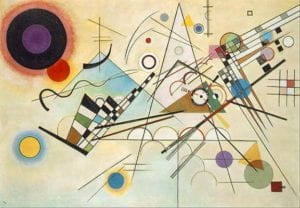Emrich’s essay mentioned a case of synesthesia which was included in John Locke’s text on human understanding – a blind man who perceived the sound of a trumpet in scarlet red (416). The correlation between a color and a musical instrument instantly reminded me of Wassily Kandinsky, the Russian artist who pioneered in Abstraction both in painting and theory. Although the Abstraction movement’s huge impact on contemporary art and design has its strongest emphasis on visual elements without its initial meaning – the awakening of spirituality, being fully understood or appreciated, its aesthetics is still often reflected by the pop culture today.
According to Emrich, the experience of synesthesia consists of perceiving multiple senses simultaneously (414). A synesthete doesn’t receive a piece of visual or audio information solely, instead, a synesthete’s impression of objects or words is based on the coupling of sensual perceptions including emotions. In Concerning the Spiritual in Art, Kandinsky provided a formula where each color choice suggests a particular emotion – for example, while he sees blue as peaceful and calming, yellow is full of disturbing sentiments. As a music lover, Kandinsky also depicted notes and sounds through combining colors and shapes. In his creative world, paintings became compositions.The contribution to the art world made by Kandinsky or any other abstract painter around his era was beyond inventing a new form to capture sounds or emotions using brushes. Through freeing the painting subjects from objects, abstract painters pursued the purity of senses, explored the essence of an individual soul, and formed a unique conversation with the spiritual world. Kandinsky’s art invites each viewer to become a synesthete in tracing the perceptions and inspirations involved in the creating process.

Wassily Kandinsky, Composition VIII (1923), Oil on canvas, Solomon R. Guggenheim Museum
Emrich, Hinderk M., Janina Neufeld, and Christopher Sinke. “Synesthesia, a Neurological Phenomenon.” In See This Sound: Audiovisuology a Reader, 414–23. Köln: Verlag der Buchhandlung Walthar Köning, 2015.